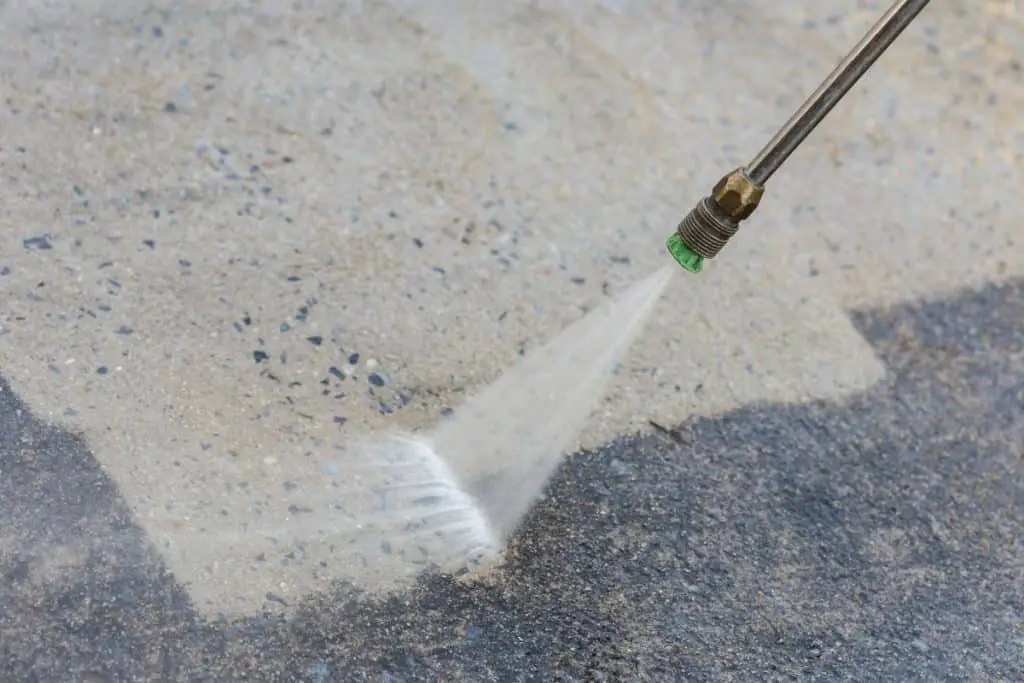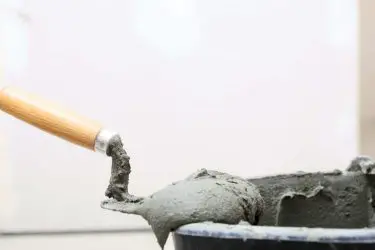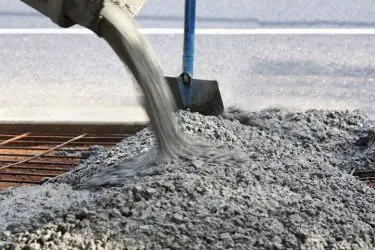Finally, the new concrete slab is in. The porch or sidewalk looks amazing until blotches of different colors start appearing. Discoloration in concrete, while not very common, can pose real problems that require maintenance or a new concrete pour.
Concrete becomes discolored because of irregularity during the formation process. This can include an inconsistent mixture, using cement alternatives, poor workmanship, or readjusting the set-up time which can lead to patches of odd color and non-uniform concrete.
Concrete turns a variety of colors for a variety of different reasons and each of those reasons has different solutions. Below we can see the causes and solutions necessary to once again make concrete look new.

Table of Contents
Reasons For Discoloration
There are a variety of reasons that concrete can be discolored but most of them relate to the inconsistency in the mixture or another aspect of the process.
- Inconsistency in the Mixture: Throughout the process, your mixture must maintain the same ratios. Each ingredient should be the same proportion as before, containing the same amount of water and cement as the last mixture. If differences do occur, it makes the concrete patchy and discolored. Also, be sure that all the ingredients you use are up to the standard set by the American Society for Testing and Materials.
- Moisture Content: A common process that happens at the job site is the addition of water to make the concrete more workable. Small discrepancies in moisture content don’t usually lead to problems, but larger ones will once again cause discoloration.
- Cement Powder Making: If you purchase a cement mixture that is already a little off in color, the chances of that also happening to the finished product are high. Because of the variety of temperatures and procedures used when making concrete, the color may come out slightly different.
- Cement Replacements: Normally, Portland Cement is the most popular to mix your concrete, but with the new fad of ‘going green,’ people have started using other materials to mix cement. Often this is slag cement, or fly ash that comes as a result of the steel and coal industry. Using these obviously changes things a bit and can lead to discoloration of blueish green, or brown.
- Poor Workmanship: How a contractor chooses to lay the concrete, prepare for its placement, and finish it can also lead to color discrepancies. Sometimes if the concrete is finished before the bleed has ceased, it will cause blotches of color.
Specific Discoloration
Is your concrete a bluish-green color, or does it have light and dark spots of orange stains? Each of these results from different aspects within the concrete formation. Whether it’s creating the cement powder, mixing the concrete with water, or curing the concrete, the results vary.
Blue/Green Discoloration
Blue and Green Discoloration are often found when slag cement is used with a mixture of Portland Cement. Slag cement is a hydraulic cement and is known for its whiteness. Within hours of being poured, and being exposed to air and sun it will turn more white than regular cement. A blueish green discoloration happens when sulfide sulfur within the slag cement reacts with other components of Portland Cement.
The bluish-green tint is not any cause for alarm as it will not compromise the strength, or durability of the concrete. As a matter of fact, after about a week the color will begin to disappear. The color also takes about one week to appear after pouring.
It is not recommended that slag cement be used for cement that will be continuously exposed to water, like swimming pools, as the discoloration may continue beyond the first couple of weeks.
Light and Dark Spots
The main culprit when it comes to light and dark spots spread across your new slab is calcium chloride. Calcium Chloride is a salt compound that is used in the stabilization of a road, ice, and dust. When pouring concrete, it is used to accelerate the drying process of a slab, but if it is not mixed in well enough, it will cause parts to try faster than others and result in splotches of darker concrete.
Another reason that darker spots can be found in concrete happens during the finishing process known as troweling. Troweling evaporates the water within the concrete causing it to be much darker than it would be without troweling.
Read more: Concrete Turning Black: Causes, prevention, and how to fix it
Orange Stains
Orange colors can appear on concrete as well, but they are usually caused by something happening around the concrete. These are referred to as rust stains, and they happen when a metal tool or decoration is left on the concrete in the rain or sprinklers. The iron and other materials found in metal and fertilizers, when mixed with water and left on the cement, lead to dark orange spots of color.
These stains can be treated like other discoloration through washing or specialized product. They can also greatly be prevented by not leaving metal on your concrete, or preventing fertilizer from being left there for an extended amount of time.
White Spots
Previously, we mentioned that the use of slag cement can result in a whiter version of regular concrete, but another white chalky substance can also appear on concrete. This substance is called efflorescence.
It comes as a result of salts used in wintertime or other salt and water mixtures. This can be fixed with a mild acid, power washing, sandblasting or, efflorescence remover, which can be purchased at most local hardware stores.
Read more: Why Does Concrete Turn White?
Discoloration Prevention
It would help if discoloration didn’t happen in the first place, and below are some ways that will help in preventing those odd colors from appearing on your concrete.
- Minimize the use of high alkali cement, because this causes discoloration.
- The forms used while pouring your concrete can also be influential. They may absorb or repel water if they are changed in the middle of the process. This can cause different moisture content and discoloration.
- Don’t trowel burn your concrete as this leaves metal fragments in the concrete that can rust or cause other discoloration.
- Cure the concrete evenly. If moist curing takes place, and a sheet is laid over the top, ensure that it is not touching in some places and not touching in other places, as this will lead to uneven drying.
- Not using calcium chloride would also help in ensuring and even drying.
How To Treat Discoloration
Removal or fixing the concrete discoloration is dependent upon what the color is a result of. For example, bluish-green concrete splotches will go away with time, but discoloration that has happened because of a trowel burning is almost impossible to remove without completely redoing the concrete. There are a variety of methods you can try dependent upon the level of discoloration.
- Brush and scrub the concrete with hot water and leave it to dry overnight. Hopefully, this will flush out the discoloration.
- If that doesn’t work, trying an acidic solution could also pose an option. Dilute it well, and be sure to wet the concrete before you apply it. Scrubbing would be helpful, and you should let it dry afterward.
- A more powerful option used only for major discoloration is diammonium citrate. Diammonium Citrate is a salt compound used to buff. When placed on your concrete, leave it for 15 minutes. Use a 30% water solution. Afterward, it should be thoroughly brushed and rinsed.
- There are also store-bought options. Depending upon your discoloration, a concrete rust remover such as Singerman Laboratories Rust Remover (link to amazon) could work. Homemade remedies of dishwasher soap or concrete lighteners may also help.

Other Factors To Remember
While all of this will be helpful, there are other factors that could be important as you prevent, understand, and remove discoloration.
- Keep in mind that often discoloration changes with times and seasons, one day the concrete could look off and be fine the next.
- Concrete is not a perfect art, it is impossible to get it completely uniform and same in color everywhere.
- When removing the discoloration, do not use too harsh of acids. Too much can eat away the cement and leave you with exposed aggregate.
- The technique you use to finish your concrete can definitely affect the color, and such techniques should be considered when determining the cause of discoloration.
- Some mineral mixtures can cause discoloration, such as silica fume.
- Concrete must be uniformly cured and tried to maintain the same shade of gray.
- If you want a darker or lighter concrete, these measures can be taken in the opposite.
In the end, great preparation and education are needed to ensure your concrete color is not compromised. When selecting a professional or brand of concrete, make sure the same mixture is being used throughout the whole process. Take into consideration the moisture content of the air and the subgrade, as well as the mixture as it is poured and cured. Don’t try speeding up the process. If discoloration does happen, determine the source so you can get it fixed as quickly as possible.



